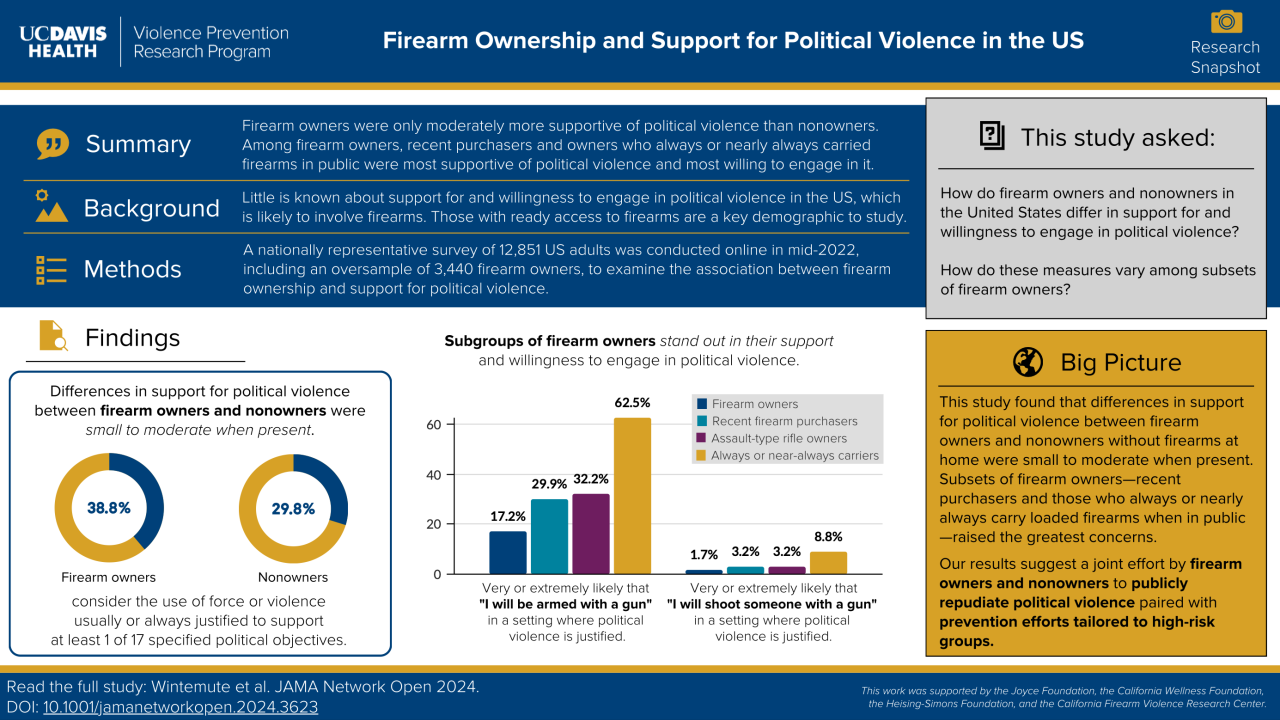
Firearm ownership and support for political violence in the United States
Quick Summary
- Our findings suggest that differences in support for political violence between firearm owners as a whole and nonowners without firearms at home are moderate, where they exist.
Importance
Little is known about support for and willingness to engage in political violence in the United States. Such violence would likely involve firearms.
Objective
To evaluate whether firearm owners’ and nonowners’ support for political violence differs and whether support among owners varies by type of firearms owned, recency of purchase, and frequency of carrying a loaded firearm in public.
Design, Setting, and Participants
This cross-sectional nationally representative survey study was conducted from May 13 to June 2, 2022, among US adult members of the Ipsos KnowledgePanel, including an oversample of firearm owners.
Exposure
Firearm ownership vs nonownership
Main Outcomes and Measures
Main outcomes concern (1) support for political violence, in general and to advance specific political objectives; (2) personal willingness to engage in political violence, by severity of violence and target population; and (3) perceived likelihood of firearm use in political violence. Outcomes are expressed as weighted proportions and adjusted prevalence differences, with P values adjusted for the false-discovery rate and reported as q values.
Results
The analytic sample comprised 12 851 respondents: 5820 (45.3%) firearm owners, 6132 (47.7%) nonowners without firearms at home, and 899 (7.0%) nonowners with firearms at home. After weighting, 51.0% (95% CI, 49.9%-52.1%) were female, 8.5% (95% CI, 7.5%-9.5%) Hispanic, 9.1% (95% CI, 8.1%-10.2%) non-Hispanic Black, and 62.6% (95% CI, 61.5%-63.8%) non-Hispanic White; the mean (SD) age was 48.5 (18.0) years. Owners were more likely than nonowners without firearms at home to consider violence usually or always justified to advance at least 1 of 17 specific political objectives (owners: 38.8%; 95% CI, 37.3%-40.4%; nonowners: 29.8%; 95% CI, 28.5%-31.2%; adjusted difference, 6.5 percentage points; 95% CI, 4.5-9.3 percentage points; q < .001) but were not more willing to engage in political violence. Recent purchasers, owners who always or nearly always carry loaded firearms in public, and to a lesser extent, owners of assault-type rifles were more supportive of and willing to engage in political violence than other subgroups of firearm owners.
Conclusions and Relevance
n this study of support for political violence in the United States, differences between firearm owners and nonowners without firearms at home were small to moderate when present. Differences were greater among subsets of owners than between owners and nonowners. These findings can guide risk-based prevention efforts.
Media Resources
- Read the study in JAMA Network Open
- View the visual abstract
